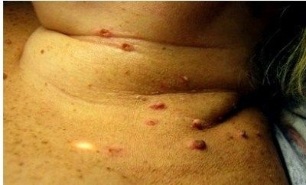
Looking at various photos of papillomas in women, hardly anyone would want such neoplasms to appear on your body. But growths can form in the most inconvenient moment and sometimes extremely uncomfortable places.
The same papillomas on female genitals, in the urethra or papillomas in the bladder in women are much more dangerous than simple warts on the body. How are they identified, what to do with them and who to contact? You will find the answer to these and many other questions in this material.
Causes of papilloma formation
The main causes of growth are the penetration of various strains of the human papillomavirus into the body. A type 16 virus is considered dangerous in women, 18 and 31. We will talk about them later.
Viruses of 16 types in women, 18 or 31 types in women are only a small fraction of the varieties discovered to date. At the same time, scientists are convinced that more than one species will be discovered in the near future.
The course of the disease, the nature of external manifestations and the complexity of papilloma treatment largely depend on the type of human papillomavirus in women.
The virus can infiltrate in several ways:
- Sexual contacts.The most potentially dangerous route because it transmits the virus of 31 types as well as viruses of type 16 in women and 18. Many people find the manifestation of HPV impossible if you use condoms. In fact, this is a fallacy as the condom is not able to fully protect against HPV. What can we say about unprotected oral and anal sex as well as practices for non-traditional relationships.
- Contact and household.The second most popular way for women to get an infection in their body. These are the usual handshakes, hugs and kisses as well as the use of ordinary hygiene items, various tools, etc. This transmission route is possible if there are injuries, small wounds or scratches on the body.
Papilloma 16 types in women, 18 and 31 are dangerous for their oncogenicity. That is, the likelihood of encountering cancerous tumors is much higher if a type 18 virus was detected in women 16 or 31.
The very fact that a virus is present in the body, even if it is type 16, 18 or 31, does not guarantee the obligatory manifestation of papillomas, and not least the development of cancer. The development of HPV in a woman's body is affected by the general condition and the immune system.
There are special groups of risk factors that increase the likelihood of infection:
- Premature onset of an active sex life. According to statistics, in most cases, women become infected with HPV within 25 years.
- Regular changes of partners.
- Frequent abortions. It is not uncommon for intercourse to end in an unwanted pregnancy. The best remedy for many is abortion. However, because of them, the internal structure of the genitals is disturbed, which greatly simplifies the penetration of the virus.
- Presence of chronic gynecological diseases.
- Sexually Transmitted Diseases.
- Prolonged use of birth control pills.

What is a papilloma? This is just an external manifestation of the virus sitting in a woman's body. Some papillomas cause only cosmetic defects. Therefore, their removal is a simple need to get rid of the growths that ruin the appearance of the woman. But there are situations where a girl definitely needs to consult a doctor to get a full consultation and reveal all the details about the presence of a virus in the body.
It so happened that papillomas in women are more dangerous than in men. And here not only viruses of 31 types in women, 18 or 16 play a role.
According to statistics, the likelihood of developing malignant tumors in the fairer sex is higher. Therefore, it is imperative to cure papillomas. Papillomas found in women are a signal for an early visit to the doctor.
Which doctor treats papillomas? It already depends on how exactly the growths originate. If these are genitals that affect the genitals and the intimate areas, go to the gynecologist.
It is difficult to independently determine growths on internal organs, therefore a complete diagnosis of the body may be necessary. When warts appear on the skin, the first thing you do is see a dermatologist.
Views
Several groups of neoplasms are relevant to women:
- Flat papillomas.Usually, flat papillomas affect the cervix and its epithelium;
- Body warts.They are formed due to exposure to the safest strains of the virus;
- Inverted.Much like a sign of flat growth. With such neoplasms, precursors to the cervix are often diagnosed;
- Peget.Usually found on the outer labia and in areas traumatized by sex. New warts can occur near individual growths, after which they fuse into a single neoplasm. It looks like a cauliflower.
Micropapillomatosis in women manifests itself somewhat differently. Generally, such a phenomenon is considered the norm. However, if the signs that the photograph shows, be sure to check the papillomatosis for infections. Micropapillomatosis affects the labia (labia minora) and presents as several small growths.
Consequences
Only a doctor should prescribe symptoms and treatment. A specialist is able to determine from what neoplasm emerged, how to treat it, and what kind of medication to use.
Many women who see growth in themselves panic because they fear complications in the form of cancer. In fact, the percentage of such cases is negligible and is due only to gross violations in the treatment or care of neoplasms. If you do everything right, do not damage or tear the growth, the likelihood of complications will be minimal.
But what consequences can human papillomavirus cause for female representatives?
- In most cases, there are no complications. Furthermore, when the immune system is strengthened, it is not even necessary to resort to removing neoplasms. They dissolve alone.
- One of the potential hazards is reproductive disorders.
- Another complication that HPV can cause is problems when trying to conceive.
- The biggest threat is the development of cancer growth.
To avoid unpleasant consequences if there are signs of HPV, see a doctor regularly and take appropriate tests. If there are no external signs of a virus, it will still not be superfluous to check for its presence.
Practice shows that many women have HPV in the latent state, ie. that it does not manifest itself in any way. This period can last from several weeks from the moment of infection to several years. It is not uncommon for growth not to form throughout life despite the presence of a virus in the body.
Treatment
Every papilloma in women needs treatment. Another question is whether women need treatment by removal, or more gentle methods can be avoided.
Let's look at more treatment options:
- Treatment with folk medicine.It is recommended to use treatment with folk remedies only when the growth of underwear is removed. It is impossible to deal with such methods with intimate warts or in places with thin skin without consulting a doctor.
- Removal of papillomas.Relevant in cases where there are multiple growths, they interfere with normal life or cause physical discomfort. After removal of the papilloma, burning is a normal reaction, especially when it comes to cryodestruction or electrocoagulation. Laser therapy and radiation surgery are preferred, although they are more expensive.
- Sparse treatment of papillomas with medication.The purpose is to improve immunity and suppress the virus. These can be tablets, injections or topical ointments for the affected area.
If a woman is facing papillomas, you should definitely see a doctor. He will give specific recommendations depending on the current situation and characteristics of the disease course.














































































